There are many factors that can influence rapidly aging skin, including diet, environmental or sun exposure, and more. But generally, skin aging is associated with the loss of moisture. The key molecule involved in keeping our skin supple and hydrated is hyaluronan or hyaluronic acid (HA), which is naturally produced by the body and has a unique capacity to bind and retain water molecules. The largest amounts of it are found in your skin, connective tissue and eyes; around half of the hyaluronic acid in your body is present in your skin, where it binds to water to help retain moisture keeping the skin lubricated and moist. It is also present in our joints, and can help prevent joint pain – why is why supplementation has been found helpful for patients with osteoarthritis.
Some of the key roles of HA in the body include hydration, lubrication of joints, and providing a framework through which cells migrate. Having an adequate amount of HA, ensures less wrinkling, and faster wound healing. When we get injured, bruised, or cut, the creation of HA increases in the body to assist with healing, and it regulates several aspects of tissue repair, including activation of inflammatory cells to enhance immune response.
Hyaluronic acid helps wounds heal faster by regulating inflammation levels and signaling the body to build more blood vessels in the damaged area. In a study published in 2013 and conducted in France on 80 patients with leg ulcers, researchers found that patients who had gauze with hyaluronic acid applied to it had a higher number of healed ulcers, greater percentage of ulcer reduction, and less pain intensity that their control counterparts. We deplete HA during the natural aging process and also with exposure to things like ultraviolet radiation from the sun, tobacco smoke and pollution.
Generally supplementation with HA is safe; but women who are pregnant or those with a history of cancer should avoid taking it. Nagaimo or Chinese Yam is a potent food source of HA. To hear more about it, check out the video below or on my IGTV channel. -XO
P.S. My calendar is open to take FREE one on one calls. If you are a woman 30+, ready to transform your health and establish lasting health rituals set up a call with me HERE.
References:
Humbert P, Mikosinki J, Benchikhi H, Allaert FA. Efficacy and safety of a gauze pad containing hyaluronic acid in treatment of leg ulcers of venous or mixed origin: a double-blind, randomised, controlled trial. Int Wound J. 2013 Apr;10(2):159-66. doi: 10.1111/j.1742-481X.2012.00957.x. Epub 2012 Mar 8. PubMed PMID: 22405094.
Litwiniuk M, Krejner A, Speyrer MS, Gauto AR, Grzela T. Hyaluronic Acid in Inflammation and Tissue Regeneration. Wounds. 2016 Mar;28(3):78-88. Review.PubMed PMID: 26978861.
Papakonstantinou, E., Roth, M., & Karakiulakis, G. (2012). Hyaluronic acid: A key molecule in skin aging. Dermato-endocrinology, 4(3), 253–258. doi:10.4161/derm.21923
Simpson RM, Meran S, Thomas D, Stephens P, Bowen T, Steadman R, Phillips A.Age-related changes in pericellular hyaluronan organization leads to impaired dermal fibroblast to myofibroblast differentiation. Am J Pathol. 2009 Nov;175(5):1915-28. doi: 10.2353/ajpath.2009.090045. Epub 2009 Oct 1. PubMed PMID: 19808648; PubMed Central PMCID: PMC2774056.






